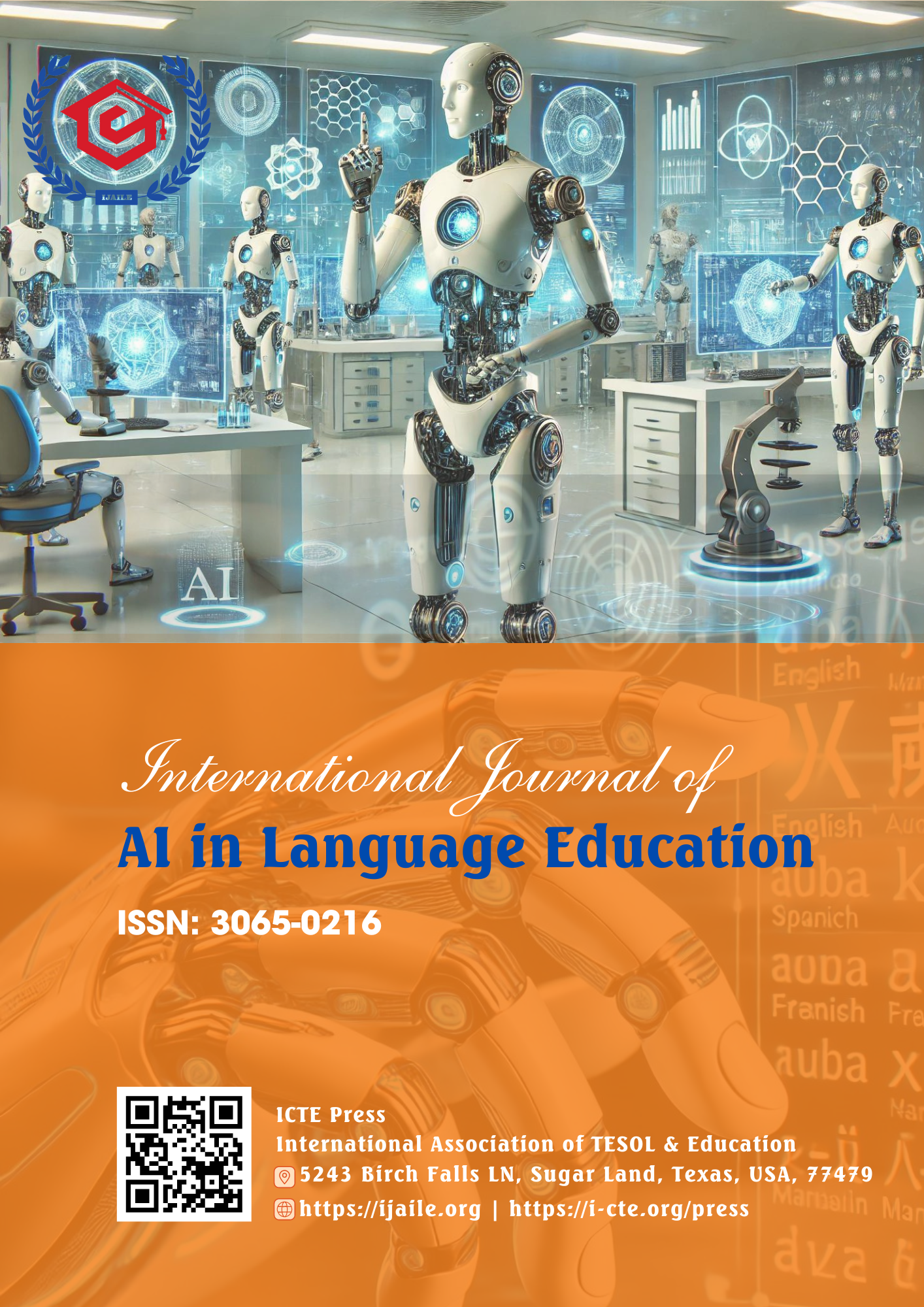Factors Affecting ICT Integration of EFL Teachers at a Vietnamese University
DOI:
https://doi.org/10.54855/ijaile.25214Keywords:
factors, EFL teachers, ICT integration, university, VietnamAbstract
Information and Communication Technology (ICT) has increasingly been applied in English teaching, with extensive research on English teachers’ ICT integration and the affecting factors. However, little has been known about the impact of the factors. This study was thus implemented to complete the gap. Employing a sequential mixed methods research design, the study recruited 81 English teachers at a Vietnamese university to complete a questionnaire and seven teachers to participate in a semi-structured interview. Drawing upon the innovation diffusion theory, the study found that the most significant impact factors were English teachers’ perceptions of ICT benefits in English teaching. The least influential factor was students’ prior experience. Other noteworthy factors included the advantage of the teachers’ English knowledge, students' motivation to use ICT, and peer support. The study offers theoretical contributions to confirm some innovations in diffusion theory variables and practical implications for the University.
References
Ahmed, S. T. S., Qasem, B. T. A., & Pawar, S. V. (2020). Computer-assisted language instruction in South Yemeni context: A study of teachers’ attitudes, ICT uses and challenges. International Journal of Language Education, 4(1), 59–73. https://doi.org/10.26858/ijole.v4i2.10106 DOI: https://doi.org/10.26858/ijole.v4i2.10106
Alkahtani, S. A. (2011). EFL female faculty members' beliefs about CALL use and integration in EFL instruction: The case of Saudi higher education. Journal of King Saud University-Languages and Translation, 23, 87-98. http://doi.org/10.1016/j.jksult.2011.04.004 DOI: https://doi.org/10.1016/j.jksult.2011.04.004
Aydin, S. (2013). Teachers' perceptions about the use of computers in EFL teaching and learning: The case of Turkey. Computer Assisted Language Learning, 26(3), 214-233. http://doi.org/10.1080/09588221.2012.654495 DOI: https://doi.org/10.1080/09588221.2012.654495
Bax, S. (2003). CALL – past, present and future. System, 31, 13-28. DOI: https://doi.org/10.1016/S0346-251X(02)00071-4
Bordbar, F. (2010). English teachers’ attitudes toward computer-assisted language learning. International Journal of Language Studies, 4(3), 27-54.
Canals, L., & Al-Rawashdeh, A. (2018). Teacher training and teachers’ attitudes towards educational technology in the deployment of online English language courses in Jordan. Computer Assisted Language, 32(7), 639-664. https://doi.org/10.1080/09588221.2018.1531033 DOI: https://doi.org/10.1080/09588221.2018.1531033
Carr, N. (2013). Graduate teachers and ICT: The prospect of transformation integration. [Unpublished doctoral dissertation]. The University of Melbourne.
Celik, S. (2013). Internet-assisted technologies for English language teaching in Turkish universities. Computer Assisted Language Learning, 26(5), 468-483. http://doi.org/10.1080/09588221.2012.692385 DOI: https://doi.org/10.1080/09588221.2012.692385
Chambers, A., & Bax, S. (2006). Making CALL work: Toward normalisation. System, 34, 465-479. DOI: https://doi.org/10.1016/j.system.2006.08.001
Chen, Y. L. (2008a). Modelling the determinants of Internet use. Computers and Education, 51, 545-558. http://doi.org/10.1016/j.compedu.2007.06.007 DOI: https://doi.org/10.1016/j.compedu.2007.06.007
Chen, Y. L. (2008b). A mixed method study of EFL teachers' Internet use in language instruction. Teaching and Teacher Education, 24, 1015-1028. http://doi.org/10.1016/j.tate.2007.07.002 DOI: https://doi.org/10.1016/j.tate.2007.07.002
Chỉ thị (Directive). 55/2008-CT-BGDDT. (2008). Retrieved from http://thaithuy.edu.vn/van-ban/van-ban-trung-uong/-/resources/e244328/chi-thi-so-55-2008-ct-bgddt-ngay-30-9-2008-ve-tang-cuong-giang-day-dao-tao-va-ung-dung-cntt.html
Cand.com.vn (2024). Tăng cường ứng dụng công nghệ trong việc dạy và học tiếng Anh. (Boosting the application of technology in English teaching and learning. Retrieved from https://cand.com.vn/giao-duc/tang-cuong-ung-dung-cong-nghe-trong-day-va-hoc-tieng-anh-i735553/
Creswell, J. W. (2018). Research design: Qualitative, quantitative, and mixed methods approaches. Sage Publications.
Creswell, J. W., & Plano-Clark, V. L. (2011). Designing and conducting mixed methods research (2nd ed.). Sage Publications.
Dang, X. T. (2012, April). Is there a role for ICT in foreign language teaching: An investigation in the context of Vietnam [Paper presentation]. Asian Conference on Technology in the Classroom, Osaka, Japan.
Dang, X. T. (2014). ICT in foreign language teaching in an innovative university in Vietnam: Current practices and factors affecting ICT use. [Unpublished doctoral dissertation]. Latrobe University.
Dang, X. T., Nicholas, H., & Lewis, R. (2012, January). Key barriers to ICT uptake in foreign language teaching in Vietnam: A case study [Paper presentation]. The International Technology, Education and Development Conference, Valencia, Spain.
Dashtestani, R. (2012). Barriers to the implementation of CALL in EFL courses: Iranian EFL teachers' attitudes and perspectives. The jalt call Journal, 8(2), 55-70. DOI: https://doi.org/10.29140/jaltcall.v8n2.134
Dinh, T. B. H. (2009, February). Factors affecting novice EFL teachers' adoption of ICT in classroom practice [Paper presentation]. CAMTESOL 5th, Phnom Penh. http:// www.camtesol.org/Publication/Selected_Papers_Vol.5_2009.pdf
Dinh, T. B. H. (2015). Factors influencing EFL teachers’ use of ICT in their classroom practice: A mixed methods study at Hanoi University, Vietnam [Unpublished doctoral dissertation]. RMIT University.
Galvis, H. A. (2012). Understanding beliefs, teachers' beliefs, and their impact on the use of computer technology. Profile, 14(2), 95-112.
Hu, Z., & McGrath, I. (2012). Integrating ICT into College English: An implementation study of a national reform. Educational Information Technology, 17, 147-165. https://doi.org/10.1007/s10639-011-9153-0 DOI: https://doi.org/10.1007/s10639-011-9153-0
Kim, H. K. (2008). Beyond motivations: ESL/EFL teachers' perceptions of the role of computers. CALICO Journal, 25(2), 241-259 DOI: https://doi.org/10.1558/cj.v25i2.241-259
Lam, Y., & Lawrence, G. (2002). Teacher-student role redefinition during a computer-based second language project: Are computers catalysts for empowering change? Computer Assisted Language Learning, 15(3), 295-315. https://doi.org/10.1076/call.15.3.295.8185 DOI: https://doi.org/10.1076/call.15.3.295.8185
Li, L., & Walsh, S. (2011). Technology uptake in EFL Chinese classes. Language Teaching Research, 15(1), 99-125. https://doi.org/10.1177/1362168810383347 DOI: https://doi.org/10.1177/1362168810383347
Liu, H., Lin, C. H., & Zhang, D. (2017). Pedagogical beliefs and attitudes toward information and communication technology: a survey of teachers of English as a foreign language in China. Computer Assisted Language, 30(8).745-765. https://doi.org/10.1080/09588221.2017.1347572 DOI: https://doi.org/10.1080/09588221.2017.1347572
Mahdi, H. S., & Al-Dera, A. S. (2013). The impact of teachers' age, gender and experience on the use of Information and Communication Technology in EFL teaching. English Language Teaching, 6(6), 57-67. https://doi.org/10.5539/elt.v6n6p57 DOI: https://doi.org/10.5539/elt.v6n6p57
Mertens, D. M. (2005). Research and evaluation in education and psychology: Integrating diversity with quantitative, qualitative and mixed methods. Sage Publications.
Mollaei, F., & Riasati, M. Z. (2013). Teachers' perceptions of using technology in teaching EFL. International Journal of Applied Linguistics and English Literature, 2(1), 13-22. https://doi.org/10.7575/ijalel.v.2n.1p.13 DOI: https://doi.org/10.7575/ijalel.v.2n.1p.13
Nguyen, T. K. C., Le, P. T. , Nguyen, T. T. H. , & Nguyen, T. M. H. (2025). Using computer-assisted language learning to improve interpretation skills for fourth-year English majors at Hanoi Open University. International Journal of AI in Language Education, 2(1), 1-19. https://doi.org/10.54855/ijaile.25211 DOI: https://doi.org/10.54855/ijaile.25211
Nguyen, T. K., & Nguyen, T. H. T. (2021). Acceptance and use of video conferencing for teaching in Covid-19 pandemic: An empirical study in Vietnam. AsiaCALL Online Journal, 12(5), 1–16. Retrieved from https://www.asiacall.info/acoj/index.php/journal/article/view/77
Nguyen, H. A. (2024). Harnessing AI-Based tools for enhancing English speaking proficiency: Impacts, challenges, and long-Term engagement. International Journal of AI in Language Education, 1(2), 18-29. DOI: https://doi.org/10.54855/ijaile.24122 DOI: https://doi.org/10.54855/ijaile.24122
Noori, A. (2019). Attitudes of Afghan EFL lecturers toward instructional technology. TechTrends, 63(2019), 170–178. https://doi.org/10.1007/s11528-018-0347-9 DOI: https://doi.org/10.1007/s11528-018-0347-9
Park, C. N., & Son, J-B. (2009). Implementing computer assisted language learning in the EFL classroom: Teachers' perceptions and perspectives. International Journal of Pedagogies & Learning, 5(2), 80-101. DOI: https://doi.org/10.5172/ijpl.5.2.80
Peeraer, J., & Petegem, P. V. (2011). ICT in teacher education in an emerging developing country: Vietnam's baseline situation at the start of "The Year of ICT". Computers & Education, 56, 974-982. DOI: https://doi.org/10.1016/j.compedu.2010.11.015
Pham, N. T., Thalathoti, V., Dakich, E., & Dang, X. T. (2012, September). English Discovery Online (EDO) - Examining learner-instructor interaction: A case study at Hanoi University, Hanoi, Vietnam [Paper presentation]. First Teleconference on ICT in ELT in Vietnam.
Quyết định (Decision) 1400/QD-TTG/2008. (2008). Retrieved from http://vanban.moet.gov.vn/?page=1.15&script=viewdoc&view=708&opt=brpage
Quyết định (Decision) 1755/QD-TTG. (2010). Retrieved from http://www.dienban.quangnam.gov.vn/images/stories/VBPQ/2010/QD1755TTG.PDF
Rahimi, M., & Yadollahi, S. (2011). Computer anxiety and ICT integration in English classes among Iranian EFL teachers. Procedia Computer Science 3, 203-209. https://doi.org/10.1016/j.procs.2010.12.034 DOI: https://doi.org/10.1016/j.procs.2010.12.034
Richards, L. (2009). Handling qualitative data: A practical guide. Sage Publications.
Rogers, E. M. (2003). Diffusion of innovations (5th ed.). The Free Press.
Sadeghi, B., Rahmani, R., & Doosti, E. (2014). L2 teachers' reasons and perceptions for using or not using computer-mediated communication tools in their classroom. Journal of Language Teaching and Research, 5(3), 663-673. https://doi.org/10.4304/jltr.5.3.663-673 DOI: https://doi.org/10.4304/jltr.5.3.663-673
Saglam, A. L. G., & Sert, S. (2012). Perceptions of in-service teachers regarding technology-integrated English language teaching. Turkish Online Journal of Qualitative Inquiry, 3(3), 1-14.
Tran, M. T., Pham, N. T. & Dinh, T. B. H. (2023). Teachers’ attitudes towards the use of Information and Communication Technology in teaching English: Impacts of teachers’ characteristics. AsiaCALL Online Journal, 14(1), 61-84. https://doi.org/10.54855/acoj.231415 DOI: https://doi.org/10.54855/acoj.231415
Zhao, Y., & Frank, K. A. (2003). Factors affecting technology use in school: An ecological perspective. American Educational Research Journal, 40(4), 807-840. DOI: https://doi.org/10.3102/00028312040004807
Zhao, Y., Pugh, K., Sheldon, S., & Buyers, J. L. (2002). Conditions for classroom technology innovations. Teachers College Record, 104(3), 482-515. DOI: https://doi.org/10.1177/016146810210400308
Zyad, H. (2016). Integrating Computers in the Classroom: Barriers and Teachers’ Attitudes. International Journal of Instruction, 9(1), 65–78 DOI: https://doi.org/10.12973/iji.2016.916a
Downloads
Published
Issue
Section
License
Copyright (c) 2025 Dinh Thi Bao Huong (Author)

This work is licensed under a Creative Commons Attribution 4.0 International License.












